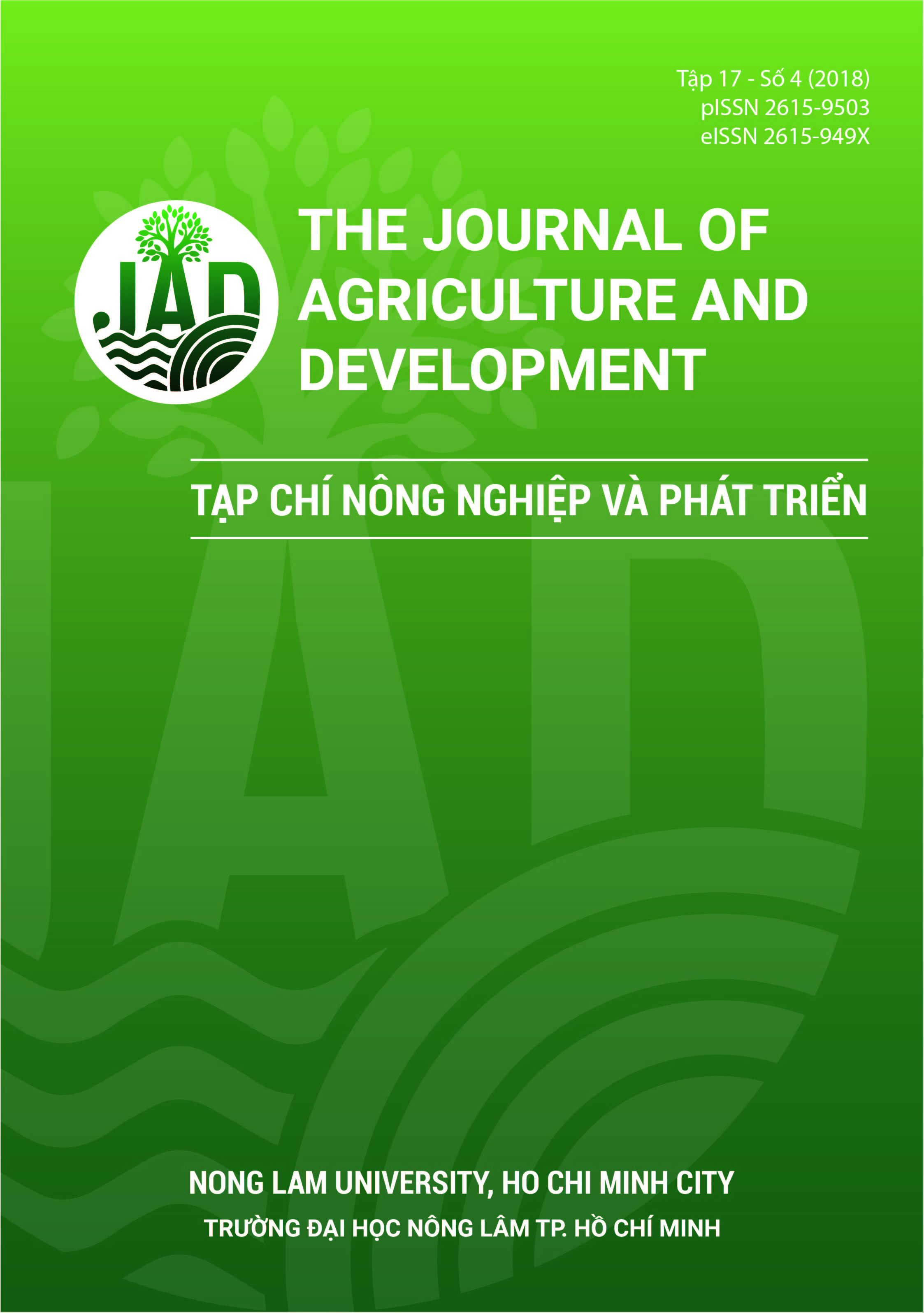Khảo sát nồng độ ức chế tối thiểu (MIC) của cao thô chiết xuất từ một số thảo dược đối với Escherichia coli, Salmonella Typhimurium và Staphylococcus aureus
Main Article Content
Tóm tắt
Mục tiêu của nghiên cứu là xác định nồng độ ức chế tối thiểu của cao thô chiết từ 5 loại thảo dược phổ biến ở Việt Nam (chè xanh, cỏ mực, hoàn ngọc, ổi, sầu đâu (neem)) đối với Escherichia coli ATCC 25922, Salmonella Typhimurium, Staphylococcus aureus ATCC 25923 bằng phương pháp pha loãng tới hạn. Những kết quả này sẽ làm cơ sở để ứng dụng các loại dược liệu trên trong phòng và trị bệnh cho vật nuôi. Kết quả của nghiên cứu cho thấy, MIC của cao chiết từ lá chè xanh đối với E.coli, S. Typhimurium và S. aureus lần lượt là 8 - 16 mg/mL, 8 - 16 mg/mL, 0,5 mg/mL; MIC của cao chiết từ lá cỏ mực đối với E.coli, S. Typhimurium và S. aureus lần lượt là 16 mg/mL, 16 mg/mL, 1 - 2 mg/mL; MIC của cao chiết từ lá hoàn ngọc đối với E.coli, S. Typhimurium và S. aureus lần lượt là 8 mg/mL, 4 - 8 mg/mL, 2 - 4 mg/mL, MIC của cao chiết từ lá ổi đối với E.coli, S. Typhimurium và S. aureus lần lượt là 16 mg/mL, 16 mg/mL, 0,125 – 0,25 mg/mL; MIC của cao chiết từ lá chè xanh đối với E.coli, S. Typhimurium và S. aureus là lớn hơn 16mg/mL.
Article Details
Tài liệu tham khảo
Aboulmagd, E., Al-Mohammed, H. I., & Al-Badry, S. (2011). Synergism and posttibiotic effect of green tea extract and imipenem against methicillin resistant Staphylococcus aureus. Microbiology Journal 1(3), 89-96. https://doi.org/10.3923/mj.2011.89.96
Amber, F., Adnan, K., Ilaria, B., Shahana, U. K., Salva-tore, R., & Bianca, P. (2015). Synergistic Antimicro-bial Activity ofCamellia sinensis and Juglans regia against Multidrug-Resistant Bacteria. Plos One 10(2), 1371. https://doi.org/10.1371/journal.pone.0118431
Archana S., & Abraham J. (2011). Comparative analysis of antimicrobial activity of leaf extracts from fresh green tea and black tea on pathogens. Journal of Applied Pharmaceutical Science 1(8), 149-152.
Bongkot, N., Sunpetch, A., Natchaya, P., & Wisarut, M. (2011). Inhibitory and Bactericidal Effects of Pseuderanthemum palatiferum and Piper betle L. Leaves Extracts Against Salmonella species. KKU Veterinary Journal 19(2), 171-179.
Do, B. H. (2006). Medicinal plants and animals in Vietnam 1, 404-419. Ha Noi: Science and Technics Publishing House.
Gustafson, R. H., & Bowen, R. E. (1997). Antibiotic use in animal agriculture. Journal of Applied Microbiology 83(5), 531-541. https://doi.org/10.1046/j.1365-2672.1997.00280.x
Gustafson, R. H., & Bowen, R. E. (1997). Antibioticuse in animal agriculture. Journal of Applied Microbiology 83, 531-541.
Madhab, R., Rafael, A. A., Berna, E., & Conny, R. S. (2013). Use of antibioticts as fed additives: a buring question. Frontiers in microbiology 5, 334. https://doi.org/10.3389/fmicb.2014.00334
Maksum, R., Rafael, A. A., Berna, E., & Conny, R. S. (2013). Antimicrobial activity of green tea extract against isolates of methicillin-resistant Staphylococcus aureus and multi–drug resistant Pseudomonas aeruginosa. Asian Pacific journal of tropical biomedicine 3(8), 663-667.. https://doi.org/10.1016/S2221-1691(13)60133-1
Maragathavalli, S., Brindha, S., Kaviyarasi, N. S., Annadurai, B., & Gangwar, S. K. (2012). Antimicrobial avtivity in leaf extract of neem (Azadirachta indica Linn.). International Journal of Science and Nature 3(1), 110-113.
Nguyen, L. T. K. (2012). Effects of garlic and turmeric on disease resistance and growth performance of 30 to 90-day-old pigs and finisher pigs (Unpublished doctoral dissertation). Nong Lam University, Ho Chi Minh City, Vietnam.
Nguyen, V. Q., & Eun, J. B. (2013). Antimicrobial activity of some Vietnamese medicinal plants extracts. Journal of Medicinal Plants Research 7(35), 2597-2605. https://doi.org/10.5897/JMPR2013.4452
Pandey, M. K., Singh, G. N., Sharma, R. K., & Lata, S. (2011). Antibacterial activity of Eclipta alba (L.) Hassk. Journal of Applied Pharmaceutical Science 1(7), 104-107.
Raja, R. R. Y, Krishna, K. C, Lokanatha, O, Mamatha, S., & Damodar, R. C. (2013). Antimicrobial activity of Azadirachta Indica (neem) leaf, bark and seed extracts. International Journal of Research in Pharmacology and Phytochemistry 3(1), 1-4.
Sanches, N. R., Garcia Cortez, D. A., Schiavini, M. S., Nakamura, C. V., & Dias Filho, B. P. (2005). An Evaluation of Antibacterial Activities of Psidium guajava (L.). Brazilian Archives of Biology and Technology 48(3), 429-436.
Tiwari, R. P., Bharti, S. K., Kaur H. D., Dikshit R. P., & Hoondal G. S. (2005). Synergistic antimicrobial activity of tea & antibioticts. Indian Journal of Medical Research 122(1), 80-84.
Victor, L. (2005). Antibiotics in Laboratory Medicine. Clinical Infectious Diseases 41(4), 577. https://doi.org/10.1086/432067
Vo, A. T. T., Marshall, B. M., Levy, S., Ochieng, D., Gur, D., Nanuashvili, A., Kim, Y. S., Byarugabe, D. K., Okoh, A., Kashyap, S. K., Endtz, H., & Sosa, A. (2010). Surveillance of antibiotic resistance determinants in commensal and environmental bacteria from international sources. Interscience Conference on Antimicrobial Agents and Chemotherapy. Boston, Massachusetts, USA.
Vo, A. T. T., van Duijkeren, E., Fluit A. C., Heck M. E. O. C., Verbruggen A., Maas, H. M. E., & Gaastra, W. (2006). Distribution of Salmonella enterica serovars from humans, livestock and meat in Vietnam and the dominance of Salmonella Typhimurium phage type 90. Veterinary Microbiology 113(1-2), 153-158. https://doi.org/10.1016/j.vetmic.2005.10.034
Wiegand, I., Hilpert, K., & Hancock, R. E. W. (2008). Agar and broth dilution methods to determine the minimal inhibitory concentration (MIC) of antimicrobial substances. Nature Protocols 3(2), 163-175. https://doi.org/10.1038/nprot.2007.521








